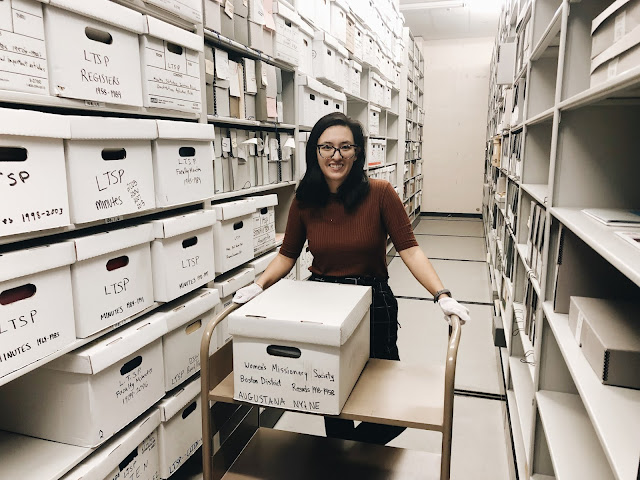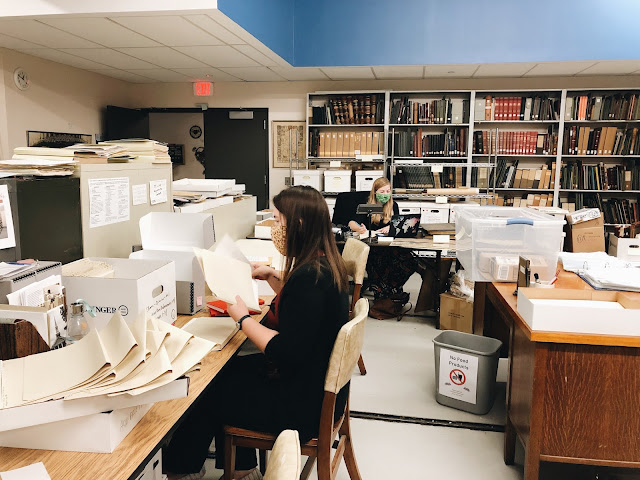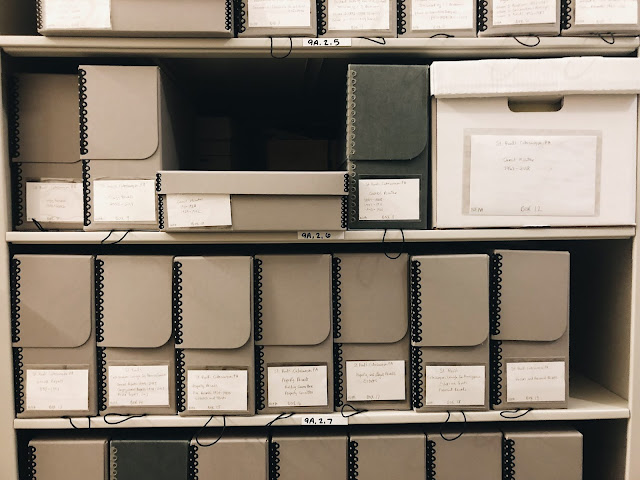What Does an Archivist Actually Do? | Associate Archivist Sheila Joy Shares Her Daily Responsibilities as an Archivist
When people ask me what I do for a living and I reply with "I'm an archivist!" they often pause and either smile or ask, "what's an archivist?" I've been asked this so many times that I've created my own "elevator pitch" that I respond with every time:
An archivist is similar to a librarian or museum curator. My goal is to preserve, arrange, and make accessible records of historical value!
With that out of the way, you may be wondering what kinds of tasks an archivist does on a regular basis. Well, keep reading to learn what you can typically find me doing at the Lutheran Archives Center!
 |
| Associate Archivist Sheila Joy in the archives stacks. |
Collections Management & Processing
My primary duty is to manage our collections, accession incoming collections, and make sure those collections get processed. Collections management involves many different tasks including:
Accessioning Collections
Accessioning is the process of creating a record or logging information about new materials that come into the archives. Important information we record includes when it was received, the donor, summary of contents, extent/number of boxes, any restrictions, and provenance. All new collections receive an accession number which is a unique identifier assigned to collections. We primarily receive collections as gifts or donations and transfers from synods in our region. As a "lone arranger" I accession every collection myself.
 |
| Over 15 boxes received from closed congregation, Zion Lutheran Church, Stamford, CT. |
Processing/Cataloging and Preservation
Once a collection is received and accessioned the next step is to process it, or physically organize and arrange the materials so the records are easily searchable by researchers. During this stage I prioritize the long-term preservation by making sure the materials are arranged into acid-free folders and boxes. Congregation collections are delegated to one of our volunteers to process.
After a collection is processed it is cataloged, meaning information about the collection is entered into our collection database, PastPerfect.
Description/Creation of Finding Aids
After a collection is processed a finding aid is created. Finding aids are documents that provide detailed information about a collection that helps researchers find records within the collection relevant to their research.
Managing Incoming and Outgoing Loans
Sometimes outside institutions are interested in borrowing materials from our collections, most commonly to be used in exhibits. And sometimes we may want to borrow materials from another archives. All loans require that proper paperwork is completed. Keep in mind that archives DO NOT loan materials to researchers to take home like a library book. All archival records and objects are to be kept in the archives under watchful eye of the archivist.
Assist the Public
Some people may think that working an archives is a lonely job where we just sit in the stacks all day, away from people. Well, that couldn't be more far from the truth! Being an archivist requires having customer service and communication skills because you correspond with people on a regular basis either by email, phone, in-person, or on Zoom. I generally correspond with people with research and genealogical questions, and assist them find collections related to their research.
Conduct Research
The function of archives is not to just house materials, but to make them accessible to the public! We welcome visitors to conduct research on-site in our archives and work with the collections themselves. Unfortunately we have not allowed visitors since March 2020 due to COVID-19 pandemic. To still make records accessible, we do provide research services where a staff member conducts research on your behalf. We hope to reopen to researchers when it is safe to do so!
 |
| Associate Archivist Sheila Joy conducts genealogical research. |
Supervise Staff & Volunteers
I'm in charge of supervising our small team and delegating tasks. Our Project Archivist, Melissa Bergoffen is working on rehousing our Ministerium of Pennsylvania Collection and I provide support, answer questions, and check-in to make sure she stays on track. Our two volunteers primarily focus on processing congregation collections, so I decide what collections need to be processed and oversee that progress is made. Earlier this year I was also supervising two archival assistants who were working on their own projects, so I spent time answering questions and providing guidance to ensure they finish strong.
Managing other people's work can become a lot of work, especially if my own work load is becoming a bit out of control! It's important that I manage my time wisely and stay on track.
 |
| Former Archival Assistants Danielle McCleary (left) and Courtney Smith (right) hard at work. |
Manage & Create Content for Social Media Platforms, Blog, and Website
One of the best ways to get our name out there and spread awareness about our collections is having a web presence. In 2019 we created our Facebook page and this year we created our Instagram and blog.
To maintain our online presence we focus on creating consistent content which requires brainstorming, writing, and publishing posts, as well as shooting or finding relevant photos for the post. Sometimes we need to create graphics too! Social media is a job in itself so we allocate a few hours a week to ensure we're focused on our primary job: the collections!
 |
| Behind the scenes of the creation process for this blog post. |
Outreach and Advocacy
Sometimes I guest speak / lecture for history classes or provide presentations on our archives and what I do as an archivist! It is very rewarding the share our collections and mission with the public, especially history and seminary students!


Comments
Post a Comment